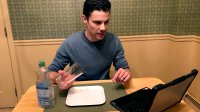Adapting Science Lessons for Distance Learning
With a little creativity, students can still take part in science experiments and discussions while learning at home.
In a traditional, face-to-face classroom setting, teachers have the ability to interact with students, flexibly spot-check understanding, and present learning material in an engaging manner. Our new normal of science teaching, the distance-learning model, has severely compromised these good instructional practices. In all likelihood, remote teaching will take up a meaningful part of the upcoming academic year. In this impersonal teaching environment, how might we maintain quality learning experiences for our students?
During distance learning, teachers may feel the need to focus on broader concepts rather than march through a typical curriculum. Educators are likely asking themselves, “What are the most essential skills that I want my kids to gain?” I would argue that memorization of fact-based content that students can easily search for online is low on the essential-skills spectrum. Substantive learning in the science classroom involves dynamic critical thinking and the ability to communicate and evaluate arguments.
I’d like to offer some tips on keeping two significant elements of science teaching alive during the remote-learning experience: phenomenon-based instruction and purposeful scientific discourse.
Presenting Scientific Phenomena
Covering scientific phenomena is the mainstay of Next Generation Science Standards–aligned instruction. Phenomenon-based learning is framed around a science mystery, or a discrepant event, to engage and motivate the student. For example, students may be asked to determine if adding six ice cubes to a drink makes it cooler than adding three. Rather than recalling discrete facts, students are tasked with applying novel information and using transferable problem-solving skills to explain a natural scientific event.
Unfortunately, we no longer have access to lab materials that would allow us to demonstrate most discrepant events to our students. Similarly, the sheer volume of science-themed video content online is downright overwhelming. Where would we even begin if we wanted to inspire a remote science lesson with a natural phenomenon?
Whether we’re trying to create demos at home or sift through videos of scientific phenomena online, the event we share must be relatable and accessible. If we’re asking students to perform mini-experiments at home, exceedingly basic materials would create an experience that was accessible to all learners. In a demonstration illustrating the properties of a cell membrane, for example, I asked my learners to use a cup, dinner plate, and dish soap to create a bubble. If we wish to share a video of a science demonstration, it would be more relatable for students to see their own science teacher perform the experiment rather than offering a YouTube video of an anonymous scientist.
I’ve had success making remote content both relatable and accessible by interjecting storytelling into my presentation of natural phenomena. When we dramatize the science mystery with captivating, student-friendly language, we can add suspense to an otherwise mundane natural phenomenon. During a recent task relating to osmosis, I replicated my typical live labs by asking students to evaluate some scenarios in which the scientific process has taken place. In one mystery, I brought out celery as a healthy snack and wondered what would happen if I placed one stalk in a beaker of salt water. The mystery here: Why did the celery become wilted and shriveled? In another scenario, a young boy won a goldfish on the boardwalk and almost released the fish in the ocean. Students are asked to consider: Why can’t a goldfish survive in salt water?
Science mysteries prime students for the learning experience. Instructional materials such as articles, interactive websites, and informative videos can now serve as evidentiary sources as students strive to describe the science behind the mystery.
Furthering Scientific Discussion
The fundamental job of a scientist is to offer, critique, and refine explanations of the natural world within a community of informed peers. In remote learning, it’s important to provide students the opportunity to share prior experiences, offer informed insights, and clarify their thinking with the help of their classmates. Such discourse allows learners to vet explanations given by others as they arrive at a shared understanding.
Video recording and screencast tools, such as Screencastify and Screencast-O-Matic, can be utilized by the science teacher to promote peer interaction. Students can use screencast software to explain a relatable science mystery through a narration of a slideshow presentation. Live meet-up tools, such as Zoom and Google Meet, are certainly useful in helping the class connect from home, but they can be a bit awkward. Many students are at a loss as to what to say. Some kids turn their cameras off and participate sparingly. Encouraging students to vocalize their ideas through a screencast allows for more structured and purposeful communication.
Responsive feedback from others is another important component of student discourse. This can be achieved by linking student screencasts to a shared Google Doc that all members of the class can access. Learners can be prompted to view a peer’s explanation of a natural phenomenon and reply to that student’s work. Guiding questions like “What is the best point this person made?” “What aspect of this argument surprised you?” and “What would you like to know more about?” drive a conversation with substance. While the experience is not nearly as immediate as face-to-face discussion, learners are still able to hone communication skills while evaluating peer arguments.
